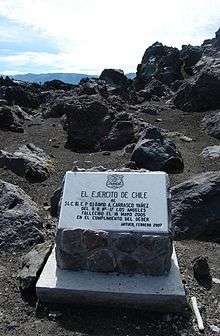Tragedy of Antuco
On May 18, 2005, Major of the Chilean Army Patricio Cereceda, on a routine training mission, ordered 474 conscripts of the 17th Regiment of Los Ángeles to March 28km along the side of the Antuco volcano at altitudes of 1,400 metres (4,600 ft) and 1,700 metres (5,600 ft) in spite of some sergeants and corporals appeals to Cereceda to cancel the order on account of the bad weather conditions. Major Cereceda stayed back at a military mountain shelter.
Of the five companies sent, only one was wearing mountain survival gear and the soldiers, most of them teenagers, had begun the conscription less than three months earlier.
As a storm struck five hours into the march, the conscripts were completely disoriented by a viento blanco (whiteout) of swirling, frozen snow that blinded and stung.
Most of them were able to hike out or hole up in shelters, but the victims, 44 conscripts and one seargent, died of hypothermia or exposure in the mountains.
Consequences
Political

It was the military's worst peacetime military disaster since 1927, when 12 Chilean cadets died in Alpatacal (Argentina), as they visited officially the independence day of Argentina.[1]
After the tragedy prominent political figures called for the abolition of the compulsory military service.
Military
The Antuco military investigation sanctioned nine officers for their responsibility in a snow training that "never should have been carried out"[2] Three career officers were forced to resign, six subordinates were officially reprimanded, and 10 soldiers were praised for their actions.
Major Patricio Cereceda, chief of Battalion, Lieutenant colonel Luis Pineda, and Colonel Roberto Mercado, commander of the Regiment were forced to retire. Beside the top officers, six junior officers received jail sentences ranging from two to ten days and punitive marks on their military records.
The Army Chief of Chile's Division III General Rodolfo González resigned as a matter of honor. In his resignation, the general assumed responsibility for the actions of his subordinates.
Judicial
Six of the men were also involved in a civilian inquiry but only Major Patricio Cereceda was sentenced to 5 years in the Punta Peuco Prison. He was released on parole on 3 November 2011, after 3 years and 9 months in prison.[3]
Indemnification
The army announced a US$5,400 in life insurance, US$4,900 in reparations, and a monthly pension of about US$260 for the surviving dependent. The Supreme Court of Chile determined an indemnification of US$ 560,000 for the 27 survivors (US$20,600 for each one)[4]
See also
- Chilean ship Cazador largest death toll in Chilean military history in peacetime
References
- ¿Quién fue el responsable del desastre ferroviario de Alpatacal?
- Death count in Chile blizzard accident climbs to 21
- Chilean Newspaper La Tercera, Antuco: mayor (R) Cereceda sale libre desde Punta Peuco, on 4 November 2011, retrieved on 13 December 2011, in Spanish language
- Chilean newspaper online El Mostrador, on 7 March 2013, Suprema confirma: Estado deberá pagar $10 millones a sobrevivientes de la tragedia de Antuco, retrieved on 7 March 2013, in Spanish language